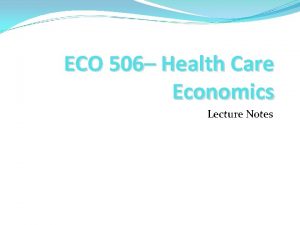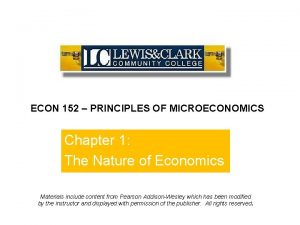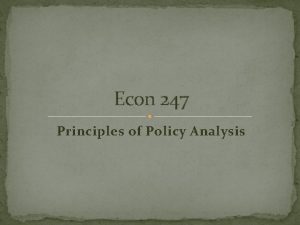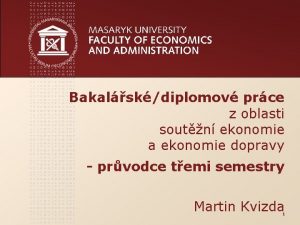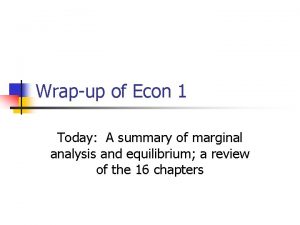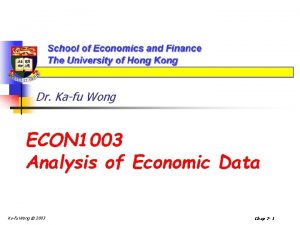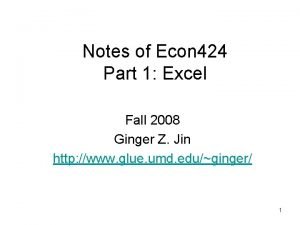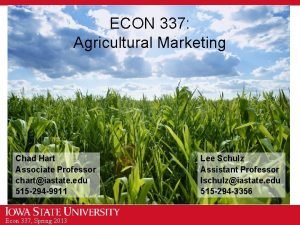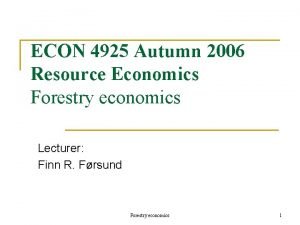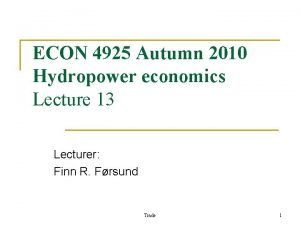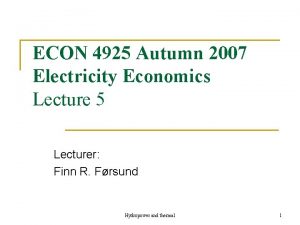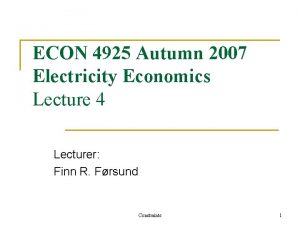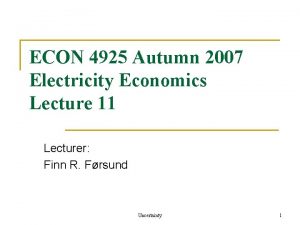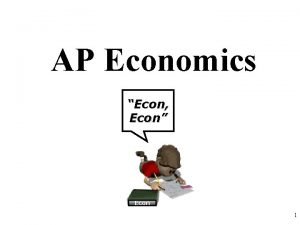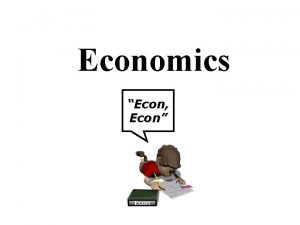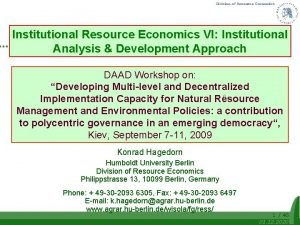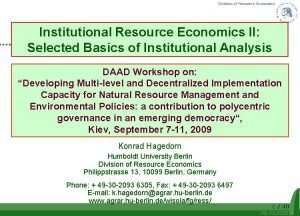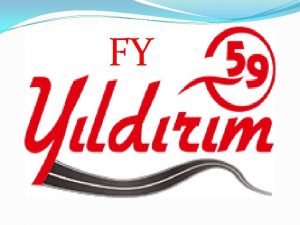ECON 4925 Resource Economics Autumn 2010 Lecture 1


















- Slides: 18

ECON 4925 Resource Economics Autumn 2010 Lecture 1 Introduction Lecturer: Finn R. Førsund 4925 Lecture 1 1

Perman et al. Chapter 1. 2. 1 • Classical economists: 1700 -1800 century – Development of natural resource economics – Adam Smith, Thomas Malthus, David Ricardo, John Stuart Mill • Economic growth: importance of natural resources (land) • Living standards in the long run subject to constraints (land) • Diminishing returns , inevitability of a stationary state ECON 4925 2

Perman et al. Chapter 1. 2. 1 • Adam Smith: markets and allocation of resources, invisible hand • Malthus: population growth geometric and food output growth arithmetic • Ricardo: subsistence wage level in steady state, land in varying quality • John Stuart Mill: diminishing returns, but also growth of knowledge and technical progress. Amenity values, first environmental economist? ECON 4925 3

Perman et al. Chapter 1. 2. 2 • Neoclassical economics: marginal theory and value in exchange • 1870+, Jevons, Menger, Marshall (consumer surplus), Walras (general equilibrium) • Production- and utility functions • Keynes: short-run use of resources • Neoclassical growth theory: absence of natural resources, introduced from 1970+ ECON 4925 4

Perman et al. Chapter 1. 2. 3 Welfare economics • Rankings of allocation must be based on ethical criterions • Utilitarian moral philosophy, Hume, Bentham, Mill. Weighted average of the total utility levels enjoyed by all individuals in the society • Pareto optimality (1897) ECON 4925 5

Perman et al. Chapter 2 • Can the global economic system continue to grow without undermining the natural systems, which are its ultimate foundation? • Can poverty be alleviated in such ways that do not affect the natural environment in such a way that future economic prospects suffer – Interrelationship between poverty, economic development and the state of the natural environment – World Commission on Environment and Development 1987 Our Common Future ECON 4925 6

Issues in resource economics • Types of resources – Non-renewables • Minerals, oil, gas, coal – Renewables • Fish, forests, water • Questions to be studied – Optimal depletion of non-renewables – Optimal harvesting of renewables

• Sustainability – Can the global economic system continue to grow without undermining the natural systems, which are its ultimate foundation? – Can poverty be alleviated in such ways that do not affect the natural environment in such a way that future economic prospects suffer – Interrelationship between poverty, economic development and the state of the natural environment – World Commission on Environment and Development 1987 Our Common Future

• Aggregate modelling – Social planner • Discounting – Care less about consumption tomorrow than today, > 0, pure rate of time preference, defective telescopic faculty (Pigou) – One believes tomorrow’s consumer will be better off than today’s

Perman et al. Chapter 3. Utilitarism • Utility discount rate ρ and consumption discount rate, r • Discounting discriminating against future generations? • Rising consumption over time may be consistent with positive discounting ECON 4925 10

Perman et al. Chapter 3 (11). • Derivation ECON 4925 11

Rules within resource economics • Two intertemporal allocation rules have attracted particular attention: the Hotelling rule and the Hartwick rule • The Hotelling rule: – No-arbitrage possibility condition that every efficient resource utilisation path has to meet. The net price of an exhaustible resource must grow at a rate that equal the interest rate ECON 4925 12

• The Hartwick rule – Invest proceeds from resource extraction such that total capital is constant • The Hartwick result – The investment rule is necessary but not sufficient for constant sustainable consumption • The relevance of the Hartwick rule for sustainability – Must have substitution between natural capital and man-made capital ECON 4925 13

Further issues • Policy instruments to achieve optimality – Taxes – Distribution; taxing Ricardian rents • Markt forms – Monopoly – Free competition • Role of ownership for utilisation of commonpool renewable resources

• Main types of models – Cake - eating model • limited amount of non-renewable resources • Hotelling’s rule – Limited non-renewable resources, production of man-made resources – Biological growth of renewable resources • Modelling the growth process • Role of steady state and sustainability • Necessary mathematical skills – Optimal control theory – Dynamic programming

The cake-eating model • A two –period model, consumption C of a finite resource during the two periods – Discounting of utility in period 2 with factor • Problem: when to eat the cake and how much • Solution • Hotelling’s rule

• Generalisation to depletion on the interval to – t 1 of a resource consuming Rt at time t • Introducing a consumption good produced using resources and capital

• Biological growth of a renewable resource • Objective function: – Maximising present value of net utility of harvest of the resource, specifying e. g. a current variable cost function of harvesting
 01:640:244 lecture notes - lecture 15: plat, idah, farad
01:640:244 lecture notes - lecture 15: plat, idah, farad Chapter 1 introduction to human resource management
Chapter 1 introduction to human resource management Human resource management lecture chapter 1
Human resource management lecture chapter 1 Contemporary management theory ppt
Contemporary management theory ppt Human resource management 15th edition
Human resource management 15th edition Land use planning lecture notes
Land use planning lecture notes Health economics lecture notes
Health economics lecture notes Principles of economics powerpoint lecture slides
Principles of economics powerpoint lecture slides Perbedaan resource loading dan resource leveling
Perbedaan resource loading dan resource leveling Resource leveling is the approach to even out the peaks of
Resource leveling is the approach to even out the peaks of Maastricht university economics and business economics
Maastricht university economics and business economics Mathematical economics vs non mathematical economics
Mathematical economics vs non mathematical economics Lorne priemaza
Lorne priemaza Econ 247
Econ 247 Esf muni harmonogram
Esf muni harmonogram Econ
Econ Econ
Econ Econ 424
Econ 424 Econ
Econ






